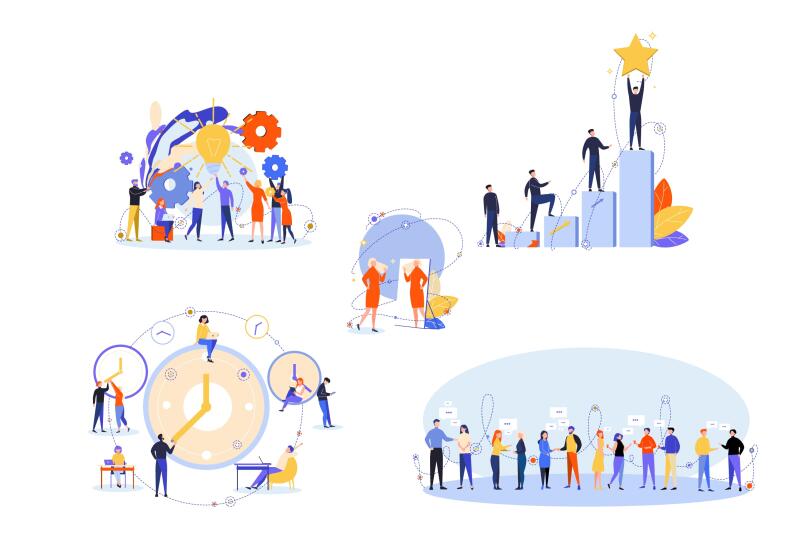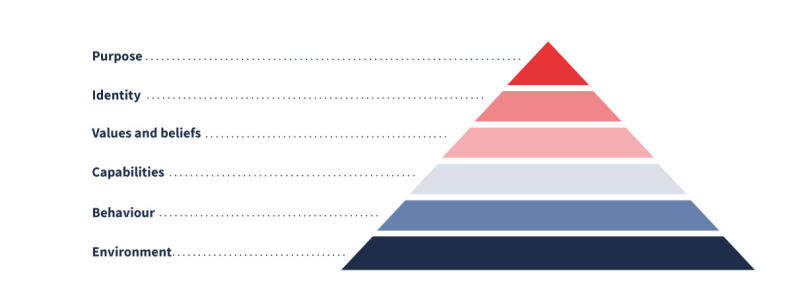Dilts pyramid
What is the Dilts pyramid?

The Dilts Pyramid is a powerful tool for finding a solution to any problem since it can help you understand exactly how and where to look for an answer. The Dilts pyramid is commonly used in advertising and marketing because it enables you to look at a client's situation from different angles and find the perfect solution to their problem, which resonates with them.
Robert Dilts, the author of the method, is one of the most famous NLP trainers and has made a substantial contribution to the development of this technique. NLP, or neuro linguistic programming, is a neuropsychological approach which postulates that there is a link between neurological processes, language, and human behaviour. The levels in the pyramid are interdependent and may also be influenced by using unique neurological techniques. One of these techniques is the Dilts pyramid.
The technique is known as the "logical pyramid of Dilts" or "the pyramid of logical levels". When using the pyramid, any problem or situation in a person's life or a business can be viewed from different levels. Thus, unknown needs and hidden problems can be revealed.
The pyramid by Robert Dilts is based on the concept that no problem can be solved by just staying at the same level: to find the best solution, you need to go to a higher level.
The Dilts pyramid levels
Dilts 'pyramid, or Robert Dilts' logical level pyramid, describes the structure of any situation, a problem, or a company using a logic level model. According to this model, you can discover the same structural elements in every case. By analysing those levels, it is possible to acquire new insights into the situation. The pyramid of logical levels by Robert Dilts contains the following levels (the list starts at the lower levels and ends at the top)

- Environment. The environment is our living conditions. Dilts' logical levels are based upon the objective reality of a particular person: their living conditions, where they live, and their surroundings.
- Behaviour. An individual's actions. If the first level is the circumstances of our life the second level is our reaction to those circumstances.
- Capabilities. This is the level of an individual's skills and experiences. The central question for this level is: "How can I influence the world? What can I do? What do I know?"
- Values and beliefs. At this level, a person structures their values and beliefs, answering why they think in this way and why not differently? What kind of childhood they had, and how their beliefs might be influenced by certain patterns of thinking?
- Identity. In simple terms, identity is the answer to the question "Who am I?" What group does the individual identify with, and how do they view themselves in the world?
- Purpose. This is the highest level that deals with values and life meaning. At this level, an individual answers the question, "What am I living for?" Often, the underlying causes of our problems and their solutions are found in lower levels.
After analysing the situation from different angles, finding a new and more effective solution is now possible. To achieve this, you will need to know how to work with the Dilts pyramid.
How to use the Dilts pyramid

The Dilts pyramid is effective when dealing with any kind of problem. How do you use it? First, it is essential to properly formulate your questions and issues. Before you begin working with the pyramid, you need to write down on paper the problems you want to work with. This step is often considered unnecessary, but it is essential to achieve the best results.
Next, you need to determine what level the problem belongs to. It is often hard to do this on your own. A therapeutic session with a psychologist or a coaching session will help. When an individual realises the problem level, they need to look at a couple of levels above it and search for a solution.
What might initially appear to be a question of values and beliefs often ends up being, for example, a question of the environment. A book on developing skills that will help you become part of a more interesting community will help solve this issue rather than a neuropsychological treatise. For example, suppose you are working with the pyramid on your own. In that case, it is recommended that you analyse the problem, starting from the base of the pyramid and moving on up to the top. Then in the reverse order: from the top of the pyramid to the bottom.
An example of using the pyramid: a woman was concerned that her boss didn't take her seriously. Moving from the base of the pyramid, she thought this was her main problem, on the last level, however, she discovered that she needed a promotion to gain self-confidence. The technique helped her to accurately pinpoint the problem and establish where the problem lied. It was at the level of value. When searching for a solution to a problem, she had to look a couple of levels higher. The solution was in realising her identity or mission.
The Dilts pyramid helps to systematically analyse your problems and, in some instances, enables you to come up with surprising conclusions. It can be used not only to find your own answers, but also when analysing the benefits of a product for a customer or when searching for marketing ideas. The disadvantage of this approach is that it can be difficult to independently explore the problem through the levels of the Dilts pyramid. If this is the case, it would be better to resort to the assistance of a coach or a psychologist.























